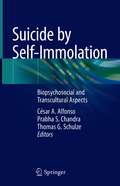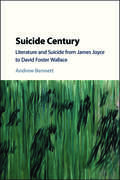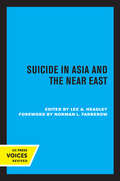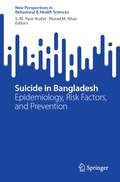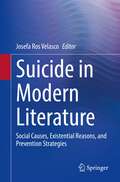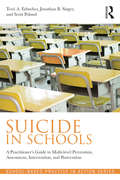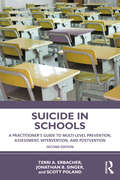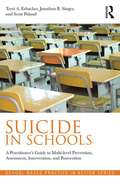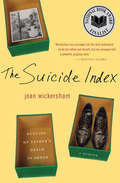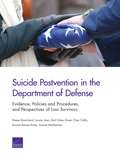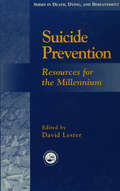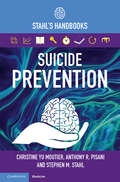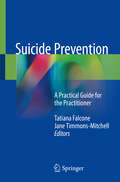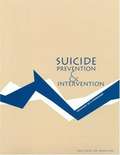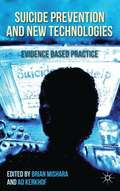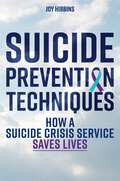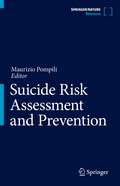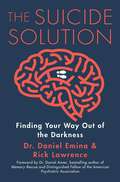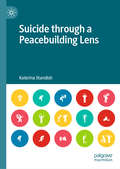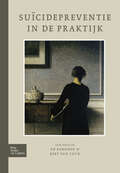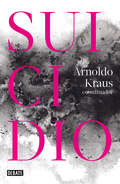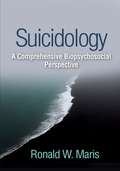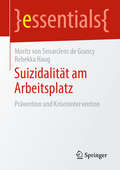- Table View
- List View
Suicide by Self-Immolation: Biopsychosocial and Transcultural Aspects
by César A. Alfonso Prabha S. Chandra Thomas G. SchulzeThis book addresses biopsychosocial and transcultural determinants of suicide by self-immolation, populations at risk throughout the world and prevention strategies specifically designed for young women in fragile environments. Self-immolation, the act of burning oneself as a means of suicide, is rare in high-income countries, and is usually a symbolic display of political protest among men that generally receives international media coverage. In contrast, in low- and-middle-income countries it is highly prevalent, primarily affects women, and may be one of the most common suicide methods in regions of Central and South Asia and parts of Africa. Psychiatric conditions, like adjustment disorders, traumatic stress disorders, and major depression, and family dynamics that include intimate partner violence, forced marriages, the threat of honor killings, and interpersonal family conflicts in a cultural context of war-related life events, poverty, forced migration and ethnic conflicts are important contributing factors. Written by over 40 academic psychiatrists from all continents, sociologists, and historians, the book covers topics such as region-specific cultural and historical factors associated with suicide; the role of religion and belief systems; marginalization, oppression, retraumatization and suicide risk; countertransference aspects of working in burn centers; responsible reporting and the media; and suicide prevention strategies to protect those at risk.
The Suicide Case - Safar Rahasyon Kaa: दि सुसाइड केस: सफ़र रहस्यों का
by Supriya Pravahहिमालय यात्रा से आने के सिर्फ तीन दिन बाद ही सुपरस्टार आरव की लाश रेल की पटरी पर मिलती है। आरव की संदेहास्पद मौत की जाँच करते हुए उसकी एक्स गर्लफ्रेंड एसीपी कलसी, उसका दोस्त दीपक व उसका वकील अरुणाचल पहुंचते है। नन्हे लामा और वकील के लापता होते ही एसीपी कलसी के शक की सुई वकील पर अटक जाती है। आखिर क्या है आरव की मौत का राज? मुंबई से अरुणाचल, नेपाल, तिब्बत, कैलाश और फिर मुंबई से इंदौर, रुड़की तक के इस रोमांचक रहस्यमई यात्रा में मर्डर मिस्ट्री के साथ दोस्ती, प्यार, व्यथा और भावुकता है। यह अद्भुत कहानी है एक मानव जीवन के संघर्ष, उसके जीने की इच्छा और आत्मदर्शन की।
Suicide Century: Literature and Suicide from James Joyce to David Foster Wallace
by Andrew BennettSuicide Century investigates suicide as a prominent theme in twentieth-century and contemporary literature. Andrew Bennett argues that with the waning of religious and legal prohibitions on suicide in the eighteenth and nineteenth centuries and the increasing influence of medical and sociological accounts of its causes and significance in the twentieth century, literature responds to the act and idea as an increasingly normalised but incessantly baffling phenomenon. Discussing works by a number of major authors from the long twentieth century, the book explores the way that suicide makes and unmakes subjects, assumes and disrupts meaning, induces and resists empathy, and insists on and makes inconceivable our understanding of ourselves and of others.
Suicide in Asia and the Near East
by Lee A. HeadleyThis title is part of UC Press's Voices Revived program, which commemorates University of California Press’s mission to seek out and cultivate the brightest minds and give them voice, reach, and impact. Drawing on a backlist dating to 1893, Voices Revived makes high-quality, peer-reviewed scholarship accessible once again using print-on-demand technology. This title was originally published in 1983.
Suicide in Bangladesh: Epidemiology, Risk Factors, and Prevention (New Perspectives in Behavioral & Health Sciences)
by S. M. Yasir Arafat Murad M. KhanThis book is about suicidal behavior in Bangladesh. The book aims to be a comprehensive book on suicidal behavior in Bangladesh, based on existing evidence and expertise covering epidemiology, sources of quality data, local culture, forensic and legal aspects, health and mental health care, media and suicide, crisis management system, suicide prevention, and status of evidence in the country. This book is the first of its kind to address multiple aspects of suicidal behavior in Bangladesh.
Suicide in Modern Literature: Social Causes, Existential Reasons, and Prevention Strategies
by Josefa Ros VelascoThis book analyzes the social and contextual causes of suicide, the existential and philosophical reasons for committing suicide, and the prevention strategies that modern fictional literature places at our disposal. They go through the review of Modern fictional literature, in the American and European geographical framework, following the rationales that modern literature based on fiction can serve the purpose of understanding better the phenomenon of suicide, its most inaccessible impulses, and that has the potential to prevent suicide.From the turn of the 20th century to the present, debates over the meaning of suicide became a privileged site for efforts to discover the reasons why people commit suicide and how to prevent this behavior. Since the French sociologist and philosopher Émile Durkheim published his study Suicide: A Study in Sociology in 1897, a reframing of suicide took place, giving rise to a flourishing group of researchers and authors devoting their efforts to understand better the causes of suicide and to the formation of suicide prevention organizations. A century later, we still keep on trying to reach such an understanding of suicide, the nature, and nuances of its modern conceptualization, to prevent suicidal behaviors.The question of what suicide means in and for modernity is not an overcome one. Suicide is an act that touches all of our lives and engages with the incomprehensible and unsayable. Since the turn of the millennium, a fierce debate about the state’s role in assisted suicide has been adopted. Beyond the discussion as to whether physicians should assist in the suicide of patients with unbearable and hopeless suffering, the scope of the suicidal agency is much broader concerning general people wanting to die.
Suicide in Schools: A Practitioner's Guide to Multi-level Prevention, Assessment, Intervention, and Postvention (School-Based Practice in Action)
by Terri A. Erbacher Jonathan B. Singer Scott PolandSuicide in Schools provides school-based professionals with practical, easy-to-use guidance on developing and implementing effective suicide prevention, assessment, intervention and postvention strategies. Utilizing a multi-level systems approach, this book includes step-by-step guidelines for developing crisis teams and prevention programs, assessing and intervening with suicidal youth, and working with families and community organizations during and after a suicidal crisis. The authors include detailed case examples, innovative approaches for professional practice, usable handouts, and internet resources on the best practice approaches to effectively work with youth who are experiencing a suicidal crisis as well as those students, families, school staff, and community members who have suffered the loss of a loved one to suicide. Readers will come away from this book with clear, step-by-step guidelines on how to work proactively with school personnel and community professionals, think about suicide prevention from a three-tiered systems approach, how to identify those who might be at risk, and how to support survivors after a traumatic event--all in a practical, user-friendly format geared especially for the needs of school-based professionals.
Suicide in Schools: A Practitioner's Guide to Multi-level Prevention, Assessment, Intervention, and Postvention
by Terri A. Erbacher Jonathan B. Singer Scott PolandThe extensively updated second edition of Suicide in Schools provides school-based professionals with practical, easy-to-use guidance on developing and implementing effective suicide prevention, assessment, intervention, and postvention strategies. The Suicide in Schools Model provides readers with clear, step-by-step guidelines on how to work proactively with school personnel and community professionals, how to screen, assess, and monitor suicide risk, create collaborative safety plans, and plan for reentry after a suicidal crisis. The authors expand this new edition with detailed case examples and innovative approaches such as upstream prevention strategies, usable handouts, and internet resources to effectively work with youth facing a suicidal crisis as well as students, families, and school staff who have suffered a suicide loss. Updates include expanding the literature on cyberbullying and social media, the higher risk of suicide in ethnoracial minoritized youth and LGBTQ+ students, and the role of suicide in school violence. This book is essential reading for school-based administrators, crisis team members, and mental health professionals as well as for outside providers who work collaboratively with school districts.
Suicide in Schools: A Practitioner's Guide to Multi-level Prevention, Assessment, Intervention, and Postvention (School-based practice in action series)
by Scott Poland; Jonathan B. Singer; Terri A. ErbacherThe authors include detailed case examples, innovative approaches for professional practice, usable handouts, and internet resources on the best practice approaches to effectively work with youth who are experiencing a suicidal crisis as well as those students, families, school staff, and community members who have suffered the loss of a loved one to suicide.
The Suicide Index: Putting My Father's Death in Order
by Joan WickershamNational Book Award Finalist: &“Wickersham has journeyed into the dark underworld inside her father and herself and emerged with a powerful, gripping story.&” —The Boston Globe One winter morning in 1991, Joan Wickersham&’s father shot himself in the head. The father she loved would never have killed himself, and yet he had. His death made a mystery of his entire life. Who was he? Why did he do it? And what was the impact of his death on the people who loved him? Using an index—the most formal and orderly of structures—Wickersham explores this chaotic and incomprehensible reality. Every bit of family history, every encounter with friends, doctors, and other survivors, exposes another facet of elusive truth. Dark, funny, sad, and gripping, at once a philosophical and a deeply personal exploration, The Suicide Index is, finally, a daughter&’s anguished, loving elegy to her father.
Suicide Postvention in the Department of Defense: Evidence, Policies and Procedures, and Perspectives of Loss Survivors
by Rajeev Ramchand Lynsay Ayer Gail Fisher Karen Chan Osilla Dionne Barnes-Proby Samuel WertheimerA review of the scientific evidence on suicide postvention (organizational responses to prevent additional suicides and help loss survivors cope), guidance for other types of organizations, and the perspectives of the family and friends of service members who have died by suicide provide insights that may help the U. S. Department of Defense formulate its own policies and programs in a practical and efficient way.
Suicide Prevention: Resources for the Millennium (Psychology Of Emotions, Motivations And Actions Ser.)
by David LesterThis study presents an evaluation of the past, present and future of suicidal behaviour and efforts to prevent or facilitate suicide. Authors from the varying disciplines of psychology, sociology and psychiatry analyze suicide in the opening chapters. Through the exploration of the roles of these disciplines, the roles of primary physicians, and the impact of suicide prevention education in schools, the contributors describe the history of suicidology and the changes necessary for improvement. The book concludes with a section detailing the goals and activities of organizations designed to prevent or facilitate suicide.
Suicide Prevention: Stahl's Handbooks (Stahl's Essential Psychopharmacology Handbooks)
by Christine Yu Moutier Anthony R. Pisani Stephen M. StahlThe current suicide public health crisis and advances in clinical practice have increased the need for clear, evidence-informed guidance on suicide prevention in healthcare. This clinical suicide prevention handbook is an essential resource for mental health and primary care professionals, and any practitioner aiming to ensure their practice is up-to-date, patient-centred and consistent with the most current standards of care. Starting with a summary of the science and public health model of suicide, the book offers quick tips for suicide screening, risk assessment, interventions, and follow-up communication. It discusses medicolegal risk management, how health systems can prevent suicide and provides highly specialized guidance for clinicians following the loss of a patient to suicide. Focused sections include incorporating social media into care plans, telemedicine, issues related to culture and race/ethnicity, and working with specific populations. It introduces an integrated, prevention-oriented approach to suicide prevention, incorporating realistic supports, foreseeable changes, and strategies.
Suicide Prevention: A Practical Guide For The Practitioner
by Jane Timmons-Mitchell Tatiana FalconeThis volume is a guide for the hospital workforce related to suicide prevention. Written by experts in the field, this text is the only one that also includes the revised DSM-5 guidelines. It is also the first to cover both prevention in one concise guide, offering a well-rounded approach to long- and short-term prevention. The book begins by establishing the neurobiology of suicide before discussing the populations at risk for suicide and the various environments where they may present. The book addresses the epidemiology, including groups at heightened risk; etiology, including several types of risk factors; prevention, including large-scale community-based activities; and postvention, including the few evidence-based approaches that are currently available. Unlike any other text on the market, this book does not simply focus on one particular demographic; rather, the book covers a wide range of populations and concerns, including suicide in youths, racial minorities, patients suffering from serious mental and physical illnesses, psychopharmacological treatment in special populations, and a wide array of challenging scenarios that are often not addressed in the very few up-to-date resources available.Suicide Prevention is an outstanding resource for psychiatrists, psychologists, hospitalists, primary care doctors, nurses, social workers, and all medical professionals who may interface with suicidal patients.
Suicide Prevention and Intervention: summary of a workshop
by Sara K. GoldsmithThe National Academies Press (NAP)--publisher for the National Academies--publishes more than 200 books a year offering the most authoritative views, definitive information, and groundbreaking recommendations on a wide range of topics in science, engineering, and health. Our books are unique in that they are authored by the nation's leading experts in every scientific field.
Suicide Prevention and New Technologies: Evidence Based Practice
by Brian L. Mishara Ad J. F. M. KerkhofThe internet, smartphones, computer self-help programmes and other technological advances are the new frontiers of suicide prevention, with organisations around the world rapidly expanding these services. This book provides a critical overview of new technologies in suicide prevention and presents promising practices and future perspectives.
Suicide Prevention Techniques: How a Suicide Crisis Service Saves Lives
by Joy HibbinsAn unprecedented insight into the approach used by the innovative Suicide Crisis charity, a crisis centre that has so far achieved a zero suicide rate amongst their clients. This book explains their ethos, how they work and the ways in which their services operate.The idea for the service grew out of the author's own lived experience of suicidal crisis, and her inability to find the right kind of help. This experience provides an understanding and awareness of what suicidal clients go through and the kind of help they require, and the success rate of the charity proves that the techniques used are effective. Covering relationship-building, providing intensive support, achieving a balance between protecting clients and giving them control, engaging high-risk men least likely to seek help, assessing risk accurately and more, this groundbreaking approach provides what is needed to save lives of people in suicidal crisis.The author's royalties for this book are being donated to the charity Suicide Crisis.
Suicide Risk Assessment and Prevention
by Maurizio PompiliThis book explores suicide prevention perspectives from around the world, considering both professionals’ points of view as well as first-person accounts from suicidal individuals. Scholars around the globe have puzzled over what makes a person suicidal and what is in the minds of those individuals who die by suicide. Most often the focus is not on the motives for suicide, nor on the phenomenology of this act, but on what is found from small cohorts of suicidal individuals. This book offers a tentative synthesis of a complex phenomenon, and sheds some light on models of suicide that are less frequently encountered in the literature. Written by international experts, it makes a valuable contribution to the field of suicidology that appeals to a wide readership, from mental health professionals to researchers in suicidology and students.
The Suicide Solution: Finding Your Way Out of the Darkness
by Daniel Emina Rick LawrenceThis is a book for people who are struggling to find their way out of a cave of anxiety, depression, and suicidal thoughts—and for anyone who cares for someone who&’s been lost in that cave. Suicide is now the leading cause of death among young adults 18-34, and the fourth-leading cause of death among the middle-aged. Just as a computer&’s hardware determines its foundational capabilities and its software determines how it interfaces with the world, humans&’ hardware is tied to our biology and our software dictates how we relate to others and ourselves. Together, these parts of our identity determine our functionality, limitations, and possibilities. We become the story we have decided to live inside. When Jesus said, &“I have come to set captives free,&” He meant that He came to &“de-bug&” our programming. Jesus invites us to partner with Him to bring to the surface and then move past our debilitating bugs. This book is a conversation between a minister and a psychiatrist. Informed by the clinical realities of anxiety, depression, and suicide, the authors draw from the transformational relational strategies of Jesus to chart a path into life and freedom.
Suicide through a Peacebuilding Lens
by Katerina StandishThis book, as the first exploration of suicide in Peace and Conflict Studies (PACS), illustrates the scarcity of suicide research in the discipline and argues that the leading cause of violent death worldwide is a multifaceted phenomenon that needs to be fully comprehended as a significant and often preventable form of world-wide violence. The author supplies a theoretical framework for assessing suicide as medical or instrumental, posits interdisciplinary complementarity and offers future lines of inquiry that challenge established notions of prevention. The book presents a PACS meta-theory termed ‘encounter theory’ and supplies a suicidal peacebuilding platform via relationship. This book questions why more PACS scholars aren’t turning their attention to suicide when more people die by suicide than ethnic, religious or ‘terroristic’ violence combined.
Suïcidepreventie in de praktijk
by A.J.F.M. Kerkhof and J.B. LuynNederland kent internationaal gezien een laag suïcidecijfer, namelijk 1.500 suïcides per jaar. Toch is elke suïcide er een te veel. Met dit boek willen de auteurs een bijdrage leveren aan de terugdringing van suïcides. Suïcidepreventie in de praktijk richt zich primair op wat je moet doen: welke vragen stel je, hoe stel je ze, wanneer en aan wie, hoe zorg je voor continuïteit, waar moet je op letten etc. De onderwerpen variëren van de onderkenning van suïcidale jongeren op school tot de behandeling van de chronisch suïcidale patiënt. Er worden preventief georiënteerde programma’s beschreven, handvatten geboden voor de opvang van suïcidepogers in het ziekenhuis en crisisinterventie, maar ook de hulp aan nabestaanden van een suïcide komt aan bod. Ook besteden de auteurs aandacht aan specifieke groepen zoals verslaafden, mensen met een persoonlijkheidsstoornis en ouderen met een doodswens. Daarnaast behandelen zij praktische methoden als cognitief-gedragstherapeutische interventies, interventies vanuit de dialectische gedragstherapie en de aanpak van dwangmatig piekeren over zelfdoding. Dit praktijkboek bevat vele gevalsbeschrijvingen.
Suicidio
by Arnoldo KrausSegún datos de la OMS, el suicidio es la segunda causa de defunción entre las personas jóvenes, con un total aproximado de 800 000 muertes al año a nivel mundial. Esto lo convierte en uno de los problemas de salud mental más preocupantes del presente, situación que se agrava debido a la creciente desigualdad económica y social, así como a la depresión debida a la pandemia por covid-19. En este libro, Arnoldo Kraus reúne a algunas de las voces más relevantes del panorama científico, intelectual y literario de nuestro país para discutir el fenómeno del suicidio, en un intento por comprenderlo mejor, sin mitos ni prejuicios. Algunas de las preguntas que cruzan estas páginas indagan sobre las circunstancias que propician los pensamientos suicidas, sobre la posibilidad de prevenirlo y sobre la necesidad de que no se estigmatice y se comprenda como un derecho irrenunciable cuando la vida ya no es digna ni plena. Lejos deofrecer respuestas definitivas o de censurar los hechos desde la superioridad moral, la intención principal de estos textos es propiciar un diálogo honesto y plural sobre uno de los problemas más profundos de la condición humana : la terrible angustia de sentir que la vida no vale la pena. Asunción Álvarez del Río | Roger Bartra Marisa Belausteguigoitia Rius | Sergio García Ramírez | Enrique Graue | Arnoldo Kraus | Marta Lamas | Antonio Lazcano | Jorge Linares | Ana López | Sandra Lorenzano | María Elena Medina-Mora | Eduardo Matos Moctezuma | Mineko Mori | Laura Emilia Pacheco | Vicente Quirarte | Jesús Ramírez-Bermúdez | Eunice Rendón | Latife Salame | Beatriz Vanda | José Woldenberg
Suizidalität am Arbeitsplatz: Prävention und Krisenintervention (essentials)
by Moritz von Senarclens de Grancy Rebekka HaugDas essential bespricht Aspekte des Suizidrisikos im Unternehmen und stellt Präventionsmaßnahmen und Maßnahmen zur Krisenintervention vor. Der Autor und die Autorin führen Techniken wie das Containing ein und diskutieren den Umgang mit emotionalen Reaktionen wie Hoffnungslosigkeit, Ohnmachtsgefühle oder Autoaggressivität. Psychoanalytisches Hintergrundwissen und ein kulturgeschichtlicher Überblick zum Suizid bereichern den Band. Besondere praxisrelevante Aspekte sowie rechtliche Fragen zum Suizid am Arbeitsplatz runden die Einführung ab.
The Sullivanians: Sex, Psychotherapy, and the Wild Life of an American Commune
by Alexander StilleFINALIST FOR THE 2024 GOTHAM BOOK PRIZEThe devolution of the Sullivan Institute, from psychoanalytic organization to insular, radical cult.In the middle of the Ozzie and Harriet 1950s, the birth control pill was introduced and a maverick psychoanalytic institute, the Sullivan Institute for Research in Psychoanalysis, opened its doors in New York City. Its founders, Saul Newton and Jane Pearce, wanted to start a revolution, one grounded in ideals of creative expression, sexual liberation, and freedom from the expectations of society, and the revolution, they felt, needed to begin at home. Dismantling the nuclear family—and monogamous marriage—would free people from the repressive forces of their parents. In its first two decades, the movement attracted many brilliant, creative people as patients: the painter Jackson Pollock and a swarm of other abstract expressionist artists, the famed art critic Clement Greenberg, the singer Judy Collins, and the dancer Lucinda Childs. In the 1960s, the group evolved into an urban commune of three or four hundred people, with patients living with other patients, leading creative, polyamorous lives.But by the mid-1970s, under the leadership of Saul Newton, the Institute had devolved from a radical communal experiment into an insular cult, with therapists controlling virtually every aspect of their patients’ lives, from where they lived and the work they did to how often they saw their sexual partners and their children. Although the group was highly secretive during its lifetime and even after its dissolution in 1991, the noted journalist Alexander Stille has succeeded in reconstructing the inner life of a parallel world hidden in plain sight in the middle of Manhattan. Through countless interviews and personal papers, The Sullivanians reveals the nearly unbelievable story of a fallen utopia.
